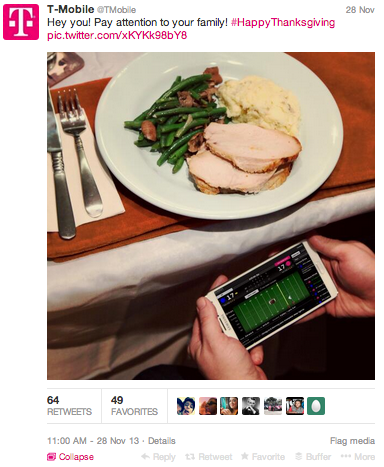Interested in what’s new in digital marketing for 2014? As 2013 comes to a close, we’re taking some time to reflect on some marketing trends of the past year and what to expect for the next. These practices aren’t simply adrift in the marketing world, this new wave of practices is moving from trend to convention. Learn what you should be adding to your digital marketing mix in part one of our digital marketing predictions for 2014.
Mobile and Location-Based Marketing
According to Nancy Bhagat, VP of Marketing Strategy at Intel, we’re going to see a huge increase in location-based marketing this year. This isn’t surprising after the news that Foursquare recently raised another $35 Million in funding. If you haven’t heard of foursquare, this gamified app allows you to compete against other users through gaining points by checking in to the places you go, all while the app mines your valuable user data, which marketers are very interested in! Users can leave tips, upload pictures, and gain badges based on how many times they’ve checked into a certain type of venue (I have a level 10 Pizzaiolo badge…and a level 1 Gym Rat badge…clearly, some priorities should be rearranged! ) You may not have the Foursquare app downloaded on your phone, but that doesn’t mean you don’t use it. If you’ve ever set a location with Instagram, Vine, Waze, Untappd or any of these other apps, you’ve used Foursquare.
In addition to Foursquare, local offers will continue to grow. Groupon, Living Social, Google Offers and Amazon Local all offer great local deals that small businesses can use to entice current customers or gain a new market. In addition to getting people in their doors, these deals give local businesses the ability to achieve some brand awareness by their target market.
Location-based marketing isn’t just for B2C companies. Our article, “Location Based Marketing for B2B and Advisory,” details how B2B companies can use location-based marketing to identify prospects, facilitate leads, use events as a way to get your brand in front of a current or prospective audience, and how to nurture current clients by keeping your company top-of-mind.
Storytelling and the Marketing Message
Your marketing message should align with your company, but should also be customer centric. Instead of always talking about yourself, talk about topics that are meaningful and valuable to your audience.
One example of a customer centric message can be seen in one of Apple’s latest holiday ads titled “Misunderstood.” The company addresses the stigma that the younger generation is constantly connected by showing that adolescents aren’t all just static consumers, but by making use of tools such as those that Apple sells, they can become creators. Although the message of this ad is a debate within itself, on the surface, I believe that this message is timely, memorable and something everyone can relate to.
According to David Williams, CEO of Merkel, relevant subject matter is no longer enough. Merkle states, “Being relevant in content will help steer a customer’s eyes in a marketer’s direction…the new metrics in attracting customer attention rely more and more on the creative contribution to the marketing mix: immediate, compelling, visceral and memorable.” “Misunderstood” meets all of these specifications.
Though Apple’s “Misunderstood” was relatable to those who hold the holidays and time with family close to their hearts, tmobile’s thanksgiving day tweet connected with those who see the holidays in a different light.
Both types of content were relatable, relevant and spoke directly to each company’s target market. We can expect more customer centric content like this in 2014.
The Medium Is Paramount
The message is essential, but equally imperative is the medium. We’re living in a time where interesting content is easier than ever to create. Using tools to create visually appealing content such as Canva, Instagram, Wideo, Vine and others, your message won’t go amiss.
Video
According to a new study, Instagram was the best platform for brands in 2013. It’s clear that Instagram hasn’t yet peaked, and we’re interested to see how brands use the social platform to engage their audiences.
Now that Facebook has rolled out videos that autoplay in the newsfeed (although muted) and vines are seen as a preview in the Twitter newsfeed, video marketing will continue to grow. Instagram and Vine are perfect tools for taking advantage of this eye-catching content strategy. One top viner, Meagan Cignoli, creates vines for a variety of brands, including Ebay, Macys, Comedy Central, Ciroc and Dolce & Gabanna to name a few. Here is a compilation of her work:
Using Vine and Instagram doesn’t mean the majority of your audience needs to be on those platforms. Think of these apps as tools with which to create great content that you can share where your audience is. You can create a vine or instagram video or phoso and post it on twitter, on your blog, on facebook and link to it in your newsletter.
Animation/Interactive
In addition to Vine and Instagram, the use of other types of rich media content such as interactive infographics will continue to grow. One great example of an interactive infographic is Your Daily Dose of Water. Additionally, scrolling websites which convey a story or message will proliferate as well, for example, A Visual History of Computers or Human Hubris.
Location based marketing, the quality of the message, and the medium, are just a few elements brands will need to keep in mind as core marketing practices in 2014. Have any predictions of your own? Leave them as a comment below!
Check out Part Two of our Digital Marketing Predictions for 2014.




1 Comment
Pingback: User Experience and Other Marketing Trends for 2015